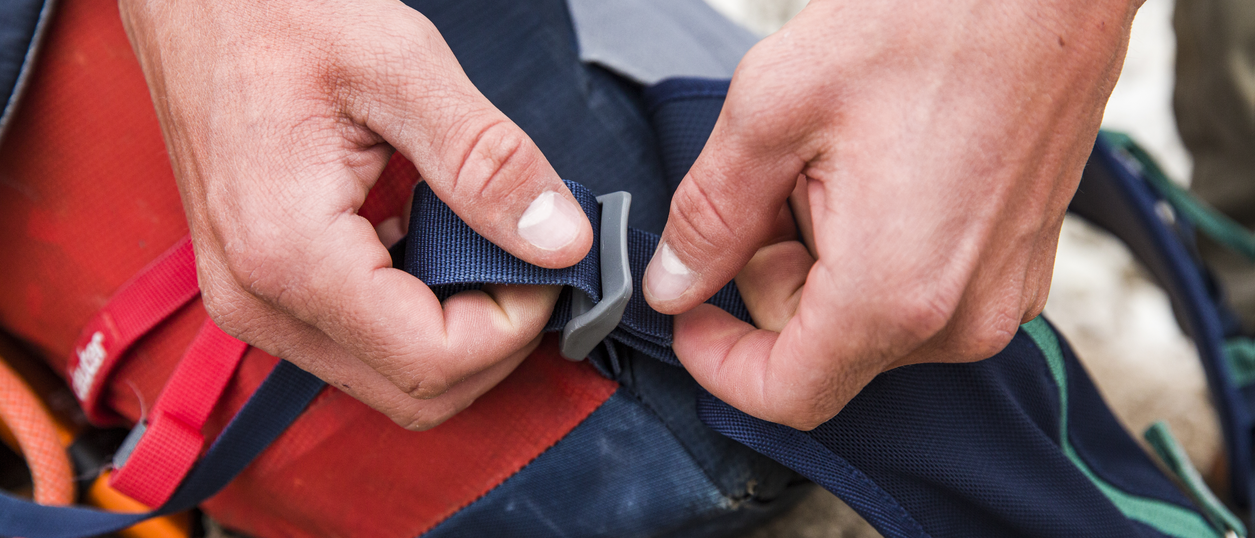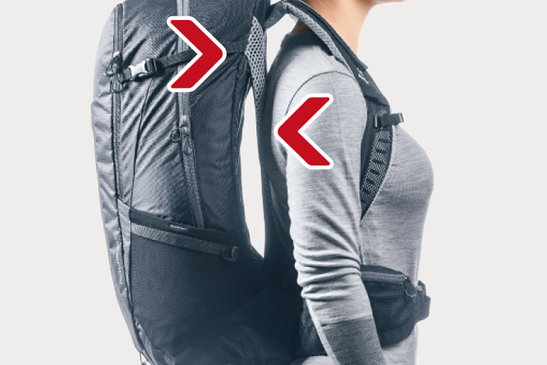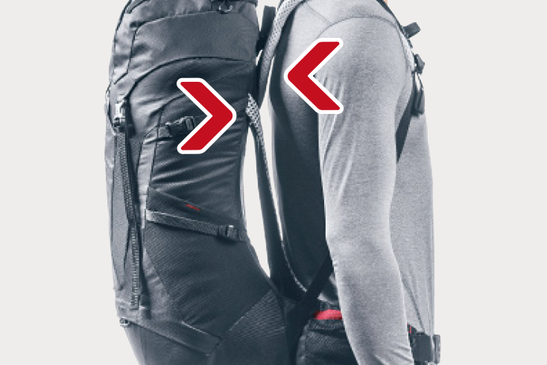Adjusting your backpack

Adjusting your backpack
What do I need to consider when adjusting & fitting my backpack?
Making sure your backpack is properly adjusted can really make a difference. Because the better it is adapted to you personally, the easier you’ll find carrying it over a longer period of time.
Contents:
Adjusting your backpack in six easy steps
How to adjust & position your backpack correctly in six easy steps
1. Loosen off all straps: When trying it on, make sure your backpack is filled with a realistic load weight and loosen off all straps, before shouldering the pack.
2. Position the hip fins: Place the center of the hip fins covering the top of the hip bone and secure the waist belt. Too high, and the belt will restrict the waist, too low and the hip fins will rub on your thighs.
3. Adjust shoulder straps: Finally pull the shoulder straps. But not too tight, because the main load should still be borne by the waist belt.
4. Check the position:: Ideally, the shoulder strap anchor points should be positioned between the shoulder blades. This will ensure the shoulder padding covers the shoulders effectively.
5. Adjust the sternum strap and buckle shut: The sternum strap stabilizes the shoulder straps and is a standard feature on most deuter backpacks. Once you’ve found the correct back length, the sternum strap can be adjusted up or down, buckled shut and then tightened. Make sure that in doing so, your breathing is not restricted.
6. Stabilizer straps: By tightening the stabilizer straps at the shoulders and on the hip fins, the load is carried closer to your back for greater control.
How to adjust your backpack: stabilizer straps
There are a few things you need to bear in mind when adjusting the stabilizer straps: Doing it right can make your hike easier, but get it wrong, and it can have the opposite effect.
-
Once your hiking backpack is correctly adjusted, you can pull on the waist belt stabilizer straps to transfer more of the load, or loosen them off for greater freedom of movement depending on the terrain.
-
With large capacity backpacks you can adjust the stabilizer straps on the shoulder straps: When they’re loose, it allows better airflow when moving over easier terrain. Pulled tight, they pull the load closer to the body for greater control when moving over more challenging terrain.
-
On longer days,loosening or tightening the shoulder straps and stabilizer straps from time to time can shift the load between the hips and the shoulders to alleviate each in turn.
-
The stabilizer straps are most effective when set at an angle between 30° and 45°.
-
With deuter’s trekking packs the correct angle is achieved by threading it through a higher or lower buckle on the body of the pack.
- With smaller capacity backpacks,and lighter loads, stabilizer straps perform a different function. Here, they can be used to make incremental adjustments to the back length. By loosening or tightening the stabilizer straps and shoulder straps, you can adjust the position of the pack on your back. The angle at which they are set in this case can be much smaller, or even negligible.
IF THE BASE OF THE PACK IS TOO HIGH…
then the back length will be too long. The shoulder strap anchor points end up too close together at the neck and the padding on the shoulder straps runs under the armpits, which can lead to chafing on the neck and arms. This also means the load will tilt backwards. And so being able to adjust the length of shoulder straps avoids this.
Even selecting the correct back length will prevent this from happening. Choosing the right back length is critical in ensuring maximum range of movement for the arms and making sure the anatomically S-shaped shoulder padding takes the strain off the neck muscles. So, for smaller backpacks, make sure you select the right size for you (Standard, SL or EL) and for larger packs adjust the back system (VariQuick) correctly.

IF THE BASE OF THE PACK IS TOO LOW…
then the back length will be too short. The padding on the shoulder straps finishes short of where it is required, the straps cut into you and the shoulder straps slip off the shoulders more easily. This is something you should always watch out for when adjusting your deuter backpack.

Using the VariQuick system to adapt the back length of your backpack — in three steps
In addition to adjusting your backpack properly, it’s also important to use it properly so that it’s comfortable for you to carry while you’re hiking, trekking or traveling. Backpack models with an adjustable back length and internal frame should therefore be set to the right length. And remember to always pack your backpack correctly! All of these factors affect the carry comfort. A badly adjusted backpack or back system, cancels out any benefits from a good-quality carry system.
Adjusting the VariQuick system:
- Determine the correct length for your back: If you need help with that, head on over to our choosing the right backpack size advice page.
- Undo the Velcro strap in the middle and pull it out
- The thread it through the 4 loops at the height you’ve chosen, in an upward direction, and fasten again.
![]()
ADJUSTING BACK LENGTHS WITH THE VARISLIDE SYSTEM — IN TWO STEPS
Super-fast precision back length adjustment:
- Lift the plastic buckle in the centre of the back panel.
- At the same time, either raise or lower the shoulder straps to the desired position.
![]()
Load, back length & carry comfort: 3 key aspects for adjusting your backpack
For loads above 10 kg, or when walking longer distances in particular, having the right back length is critical to carry comfort. Which is why it’s often better for backpacks from 35 liters’ capacity and more to be fitted with the VariQuick back length adjustment system. In just a few easy steps, the back length can be adapted to the individual. For smaller capacity packs it’s more important to keep the overall weight down. And so for these models, we offer different sizing: Regular, SL, EL. Our backpacks are designed with an average sized athletic person in mind.